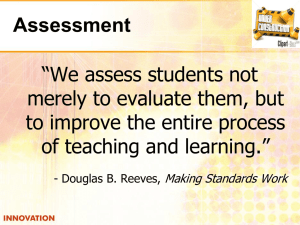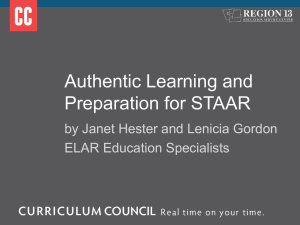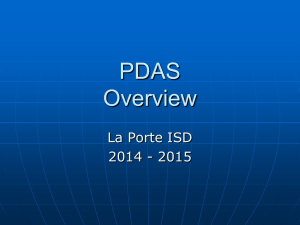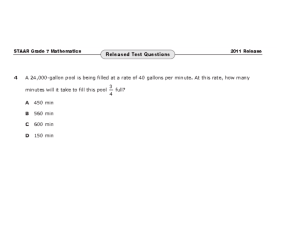Designing STAAR Quality Assessments
advertisement
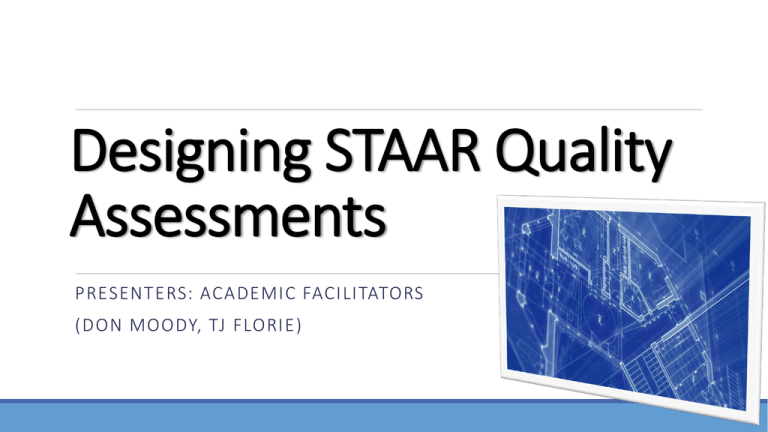
Designing STAAR Quality Assessments PRESENTERS: ACADEMIC FACILITATORS (DON MOODY, TJ FLORIE) Learning objectives Participants will review items and understand the procedural and cognitive demand of each item and ensure they are aligned with the rigor of STAAR. TodaysMeet http://todaysmeet.com/cic Core Belief Activity Table Talk At your tables discuss, what actions do you observe that run counter to the Core Beliefs of Dallas ISD. Assessment “We assess students not merely to evaluate them, but to improve the entire process of teaching and learning.” - Douglas B. Reeves, Making Standards Work Terminology •Common Assessment = ACP •Interim Assessment = formerly common assessments (ie three weeks, six weeks, unit tests) •State Assessment = (STAAR, EOC, TAKS, etc) Six Steps to Creating Quality Assessments 1. DATA: Identify and assess high priority TEKS? 2. CONTENT: Identify what students need to Know and Do 3. PROCESSES: Identify Processes and Skills and Dual code items to show application 4. REVIEW EXAMPLES: Identify generalizations about STAAR items and their implications for item and test design. 5. ITEM AND TEST LEVELING: Ensure items are at the appropriate cognitive and procedural level based on the TEKS? 6. DEVELOP QUALITY TEST ITEMS: Ensure that items well constructed. Step 5: Determining Cognitive and Procedural Difficulty Levels ALIGNING ITEM AND TEST DIFFICULTY TO STAAR Determining Difficulty Level How Difficult is this Item? Discussion At your table discuss the difference between cognitive and procedural difficulty. Determining Difficulty Level Cognitive Difficulty This is basically: How hard is question based on Blooms Taxonomy? No question on a test should be above the level of the learning objective (TEKS SE)** It is OK to have questions that are lower **Unless you have a stated learning objective that has been clearly expressed to the students and taught. Determining Difficulty Level Procedural Difficulty This is basically: How many mental processing steps does the student have to go through to answer the question? The greater the number of processing steps the higher the difficulty level Think–Pair-Share Why is determining difficulty an essential part of test design? Your Turn: Determining Difficulty Item Difficulty 1. Look at the following items 2. Identify the cognitive difficulty of the item 3. Identify the procedural difficulty of the item Item 1 Item 2 Item 3 STAAR Quality Items Determine if the following Items meet the rigor of STAAR. If the items are not STAAR Quality, how can they be rewritten to meet the rigor of STAAR. Dual Coded Items Process skills will now be: assessed in context, not in isolation, which will allow for a more integrated and authentic assessment of these content areas incorporated into test questions and reported along with content skills under the content reporting categories essential for use during instruction Brain Research and Dual Coding Application of Knowledge and Building Schema ◦The brain learns new knowledge (content) by attaching that knowledge to existing schema ◦The brain builds schema by applying conceptual and content knowledge in a variety of novel ways ◦You can most effectively test conceptual knowledge through application questions Create an item Using your chart paper create an assessment item. The item can have any combination of difficulty ( high-high, medium-high, low-medium, etc.) In Closing: 3-2-1 What are 3 things you will change on your assessments What are 2 things you are still pondering What is 1 thing you want to know more about

